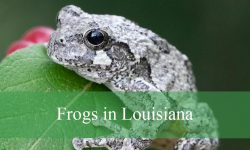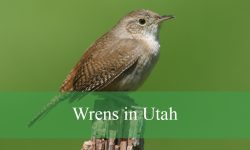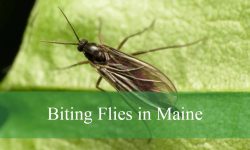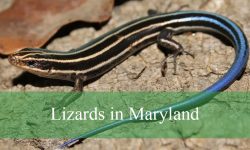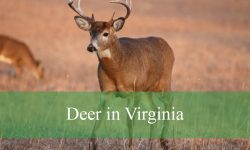Washington State boasts a wide variety of ecosystems, from rugged coastal cliffs and expansive forests to bustling urban areas. This diverse landscape provides a perfect habitat for several crow species that thrive throughout the region.
Crows are highly intelligent and adaptable birds, belonging to the Corvidae family, which also includes ravens, jays, and magpies. Their remarkable problem-solving skills and social behaviors make them one of the most fascinating birds to observe.
Despite their prevalence across the state, identifying different crow species can be tricky because many share similar physical traits. This guide will explore the four main crow species found in Washington, offering detailed information to help both casual observers and dedicated birdwatchers recognize and appreciate each one.
American Crow (Corvus brachyrhynchos)

Physical Characteristics
The American Crow is a strikingly large bird, entirely cloaked in glossy black feathers that often reflect hints of blue or purple in sunlight. Measuring between 17 and 21 inches in length and boasting a wingspan of 33 to 39 inches, this crow commands attention with its robust presence.
Its long, straight bill is perfectly suited for foraging and manipulating objects, while its fan-shaped tail provides stability in flight. The bird’s legs and feet are uniformly black, giving it a sleek, monochromatic appearance that is both elegant and functional. Observers can often notice the subtle iridescence of the feathers, especially around the neck and wings, adding a shimmering quality that sets the American Crow apart from other black birds.
Habitat and Behavior
American Crows are renowned for their adaptability, inhabiting an impressive range of environments. In Washington State, they thrive in forests, farmlands, suburban neighborhoods, and city parks, demonstrating remarkable flexibility in locating food and shelter.
Unlike some more specialized species, they can adjust to human presence, frequently foraging near roadsides or in agricultural fields. These birds are social creatures and are often observed in large groups, particularly during the colder months when communal roosting provides warmth and protection. Although they are less frequently found in high alpine zones or certain coastal regions dominated by other crow species, their widespread presence across the state reflects their ecological versatility.
Vocalizations
One of the most recognizable traits of the American Crow is its vocal ability. The familiar loud and harsh “caw-caw” is instantly associated with these birds, yet their communication repertoire is far more complex.
They produce a variety of sounds, including clicks, rattles, and cackles, which serve different purposes, from signaling alarm to coordinating with flock members. These vocalizations are frequently heard as the crows soar overhead or perch in trees, demonstrating their constant awareness of their surroundings and their social interactions within groups. Birdwatchers often rely on these calls as a primary identification tool, as the American Crow’s voice is distinct from similar species.
Diet
American Crows are opportunistic omnivores, capable of exploiting a wide variety of food sources to sustain themselves. Their diet includes insects, worms, small mammals, seeds, fruits, and even carrion, reflecting their adaptability to different environments and seasons.
In urban and suburban settings, they are known to scavenge from trash bins, picnic areas, and agricultural fields, showcasing their intelligence and resourcefulness. This diverse diet not only supports their survival across multiple habitats but also positions them as important ecological participants, contributing to pest control and the dispersal of plant seeds throughout their territories.
Northwestern Crow (Corvus caurinus)
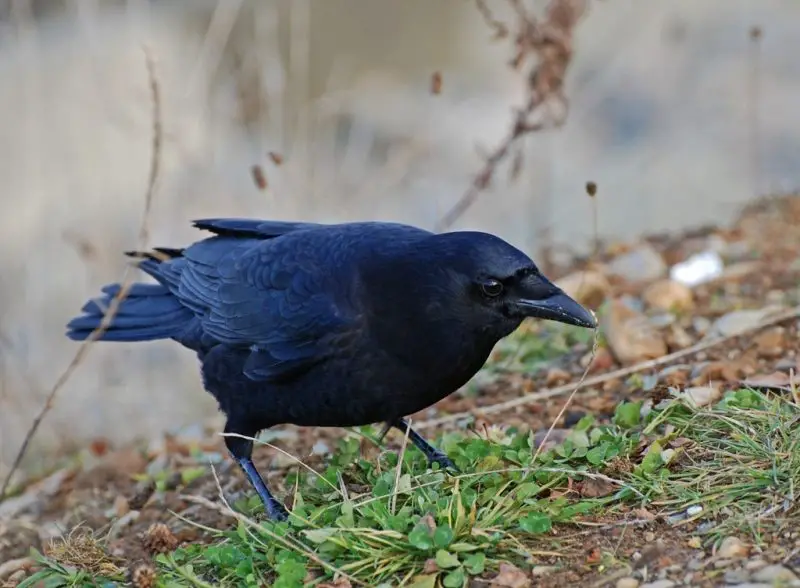
Physical Characteristics
The Northwestern Crow closely resembles the American Crow in appearance, but it is generally smaller and more compact. Measuring slightly shorter in length, this bird has a streamlined body that allows it to maneuver easily along coastal environments.
Its tail is straight or slightly rounded, distinguishing it subtly from the fan-shaped tail of the American Crow. Like other crows, its plumage is entirely black, often showing a faint iridescent sheen in sunlight. The long, solid bill is well-adapted for foraging along shorelines and in tidal areas. Compared to the American Crow, the Northwestern Crow’s overall size and slightly more delicate features give it a daintier appearance, though its intelligence and alertness remain equally striking.
Habitat and Behavior
Northwestern Crows are primarily coastal birds, inhabiting the shores from northwestern Oregon through Washington’s coastline and extending into British Columbia and Alaska. They are typically found in habitats such as beaches, estuaries, tidal flats, and near coastal urban areas.
Unlike American Crows, which are widely distributed inland, Northwestern Crows are rarely seen far from the ocean. They are social birds, often seen foraging in small groups, scavenging along the waterline, or interacting with other seabirds. Their behavior reflects a strong adaptation to coastal life, including a tendency to exploit marine resources that are unavailable to their inland relatives.
Vocalizations
The calls of the Northwestern Crow resemble those of the American Crow but are generally higher-pitched and more delicate. Their “caw” is softer and more melodic, lacking the harsh, repetitive tone commonly associated with American Crows.
These vocalizations serve as essential tools for communication within flocks, whether signaling danger, coordinating movements, or maintaining social bonds. Birdwatchers often note that distinguishing a Northwestern Crow by sound requires careful attention, as its subtle vocal differences are key to accurate identification.
Diet
Northwestern Crows primarily feed on marine resources, including small fish, crustaceans, mollusks, and other invertebrates found along tidal flats and estuaries. Their coastal foraging habits set them apart from other crow species that rely more heavily on terrestrial food sources.
In addition to marine prey, Northwestern Crows are opportunistic feeders and will scavenge human food in urban coastal areas. This adaptability ensures that they can thrive in both natural and human-influenced environments, demonstrating the same intelligence and resourcefulness seen in their inland relatives.
Common Raven (Corvus corax)
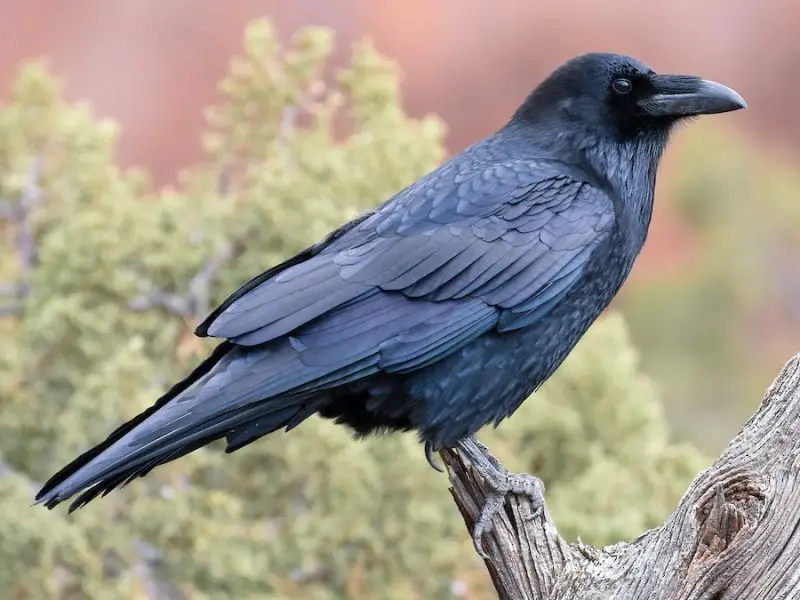
Physical Characteristics
The Common Raven is a formidable bird, significantly larger than the American Crow, measuring approximately 24 inches in length with a wingspan that can reach up to four feet. Its size alone makes it an impressive presence in the skies or perched high above the ground.
This raven is distinguished by a thick, powerful bill and shaggy throat feathers that give it a rugged appearance. In flight, the raven’s wedge-shaped tail is a key identification feature, contrasting with the fan-shaped tail of crows. Its plumage is entirely black with subtle iridescent highlights, which shimmer in sunlight, adding to its striking and commanding appearance.
Habitat and Behavior
Common Ravens are highly versatile and occupy a wide variety of habitats. In Washington State, they can be found in mountainous regions, dense forests, arid deserts, and along coastal cliffs. They are equally comfortable in rural landscapes and urban environments, demonstrating remarkable adaptability.
Often seen soaring gracefully in the sky or perched atop tall structures, ravens are both solitary and social depending on the situation. They exhibit highly intelligent behaviors, including problem-solving, play, and complex interactions with other birds. Their adaptability and keen observation skills allow them to thrive in areas that might be challenging for less versatile species.
Vocalizations
Ravens possess a diverse and complex vocal repertoire. Their calls range from deep, resonant croaks to gurgles and clicks, creating a rich tapestry of sounds that are often heard across their territories.
In addition to natural calls, Common Ravens are capable of mimicking the sounds of other birds and even mechanical noises, showcasing their impressive cognitive abilities. These vocalizations play a critical role in communication, whether to alert others to danger, establish territory, or interact socially with fellow ravens.
Diet
Omnivorous and opportunistic, Common Ravens feed on a wide range of food sources. Their diet includes small mammals, birds, insects, fruits, and carrion, allowing them to adapt to varying seasonal and environmental conditions.
Ravens are also known for caching food for later consumption, demonstrating foresight and strategic thinking. This behavior not only ensures their survival during lean periods but also underscores their intelligence, making them one of the most resourceful and fascinating birds in Washington State.
Fish Crow (Corvus ossifragus)
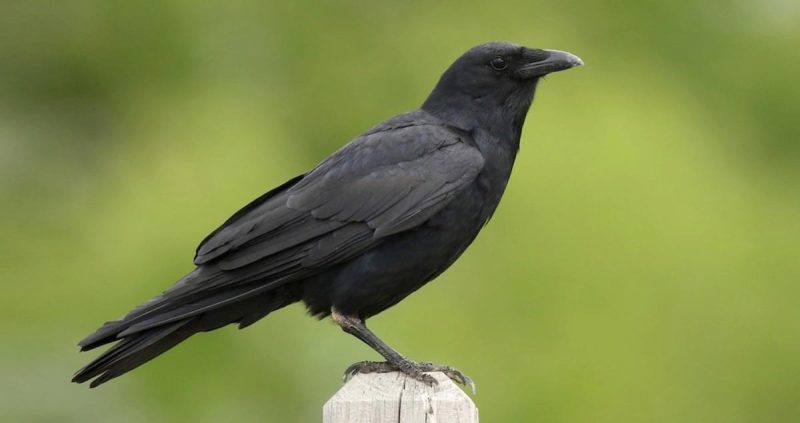
Physical Characteristics
The Fish Crow is smaller and more delicate than the American Crow, measuring about 17 inches in length with a wingspan of roughly 33 inches. Its body is slightly more slender, and the bill is smaller and less robust compared to its larger relatives.
Its plumage is entirely black, often showing subtle iridescent highlights in sunlight. The tail is straight and slightly shorter than that of the American Crow, making it appear more compact in flight. Despite its smaller size, the Fish Crow exhibits the same sleek, intelligent look characteristic of crows, with alert eyes and a sharp, curved beak designed for a coastal diet.
Habitat and Behavior
Fish Crows are primarily coastal birds, inhabiting the southeastern United States and Gulf Coast regions. They thrive in marshes, estuaries, tidal flats, and other wetland areas where food is abundant.
Unlike the American Crow, which is widespread inland, Fish Crows are rarely found away from coastal habitats. They are often observed in small flocks, foraging along shorelines or scavenging near human settlements. Their behavior demonstrates a strong adaptation to aquatic environments, including the ability to exploit marine resources effectively.
Vocalizations
The calls of the Fish Crow are somewhat similar to those of the American Crow but tend to be higher-pitched and more nasal. One of the most distinctive sounds is their “uh-uh” call, which is often heard while flying or when perched in trees.
These vocalizations play a crucial role in communication within flocks, helping the birds maintain contact and coordinate foraging activities. Birdwatchers often use the unique tonal quality of Fish Crow calls as a key identification tool, especially in coastal areas where multiple crow species may coexist.
Diet
As their name suggests, Fish Crows primarily feed on fish and other marine organisms. They skillfully forage along shorelines, tidal pools, and estuaries, using their sharp bills to capture small aquatic prey.
In addition to marine food, Fish Crows are opportunistic feeders and will scavenge human food, garbage, and other readily available resources in urban coastal areas. This adaptability ensures their survival across diverse habitats while highlighting their intelligence and resourcefulness, traits that are hallmarks of all crow species.
Comparison of Crow Species in Washington State
Feature |
American Crow |
Northwestern Crow |
Common Raven |
Fish Crow |
|---|---|---|---|---|
Size (Length / Wingspan) |
17–21 in / 33–39 in |
Slightly smaller than American Crow |
24 in / up to 48 in |
17 in / ~33 in |
Tail Shape |
Fan-shaped |
Straight or slightly rounded |
Wedge-shaped |
Straight, shorter |
Call Type |
Loud, harsh “caw-caw” |
Softer, higher-pitched “caw” |
Deep, resonant croaks, clicks |
Higher-pitched, nasal “uh-uh” |
Primary Habitat |
Forests, urban areas, farmland |
Coastal beaches, estuaries, tidal flats |
Mountains, forests, urban areas |
Coastal marshes, estuaries, tidal flats |
Diet Highlights |
Insects, small mammals, fruits |
Marine invertebrates, human food |
Small mammals, carrion, fruits |
Fish, marine organisms, human food |
Best Time and Place to Observe Crows in Washington State
Crows are highly adaptable and can be observed throughout Washington State, but certain times and locations increase the chances of successful sightings.
Best Time to Observe
The most active periods for crows are during the early morning and late afternoon. During these times, they are most engaged in foraging and social interactions, making their behaviors easier to observe.
Winter months are particularly interesting because American Crows and some Northwestern Crows often roost in large communal groups. Watching these gatherings at sunset provides a spectacular display of flight patterns and social behavior.
Best Locations to Observe
Crows can be found in a wide range of habitats, from urban parks and city neighborhoods to rural farmlands and coastal areas.
For American Crows, suburban and agricultural areas are excellent foraging grounds. Northwestern Crows are most commonly observed along the Pacific coast, tidal flats, and estuaries. Common Ravens are often seen in mountainous regions, forested areas, and even perched on tall urban structures. Fish Crows, though less common in Washington, are most likely near coastal wetland areas if they occur locally.
FAQs About Crows in Washington State
How can I tell the difference between an American Crow and a Northwestern Crow?
American Crows are slightly larger with a fan-shaped tail and a harsh “caw-caw” call. Northwestern Crows are smaller, more compact, and have a higher-pitched, softer “caw” that is more melodic.
Are Common Ravens and American Crows the same species?
No. While both belong to the Corvidae family, Common Ravens are larger, have wedge-shaped tails, shaggy throat feathers, and deeper, more resonant calls compared to American Crows.
Do Fish Crows live in Washington State?
Fish Crows are primarily coastal birds found along the southeastern and Gulf coasts of the U.S. They are rarely seen in Washington, so sightings are uncommon.
Why do crows often gather in large groups during winter?
Crows roost communally in winter for warmth and protection. These large groups also provide safety in numbers from predators and allow the birds to share information about food sources.
What is the best way to attract crows for observation?
Crows are highly intelligent and attracted to areas with accessible food sources, such as open fields, parks, and urban areas with human food waste. Observing from a distance is recommended to avoid disturbing their natural behavior.
Conclusion
While crows are among the most intelligent and adaptable birds in Washington State, distinguishing between the different species requires careful observation of their physical characteristics, vocalizations, and behaviors. By paying attention to these details, bird enthusiasts can enhance their birdwatching experience and contribute valuable observations to local wildlife databases.
For those interested in learning more about these fascinating birds, local birdwatching groups and online resources offer a wealth of information and community support. Engaging with these resources can deepen one’s appreciation for the avian diversity of Washington State.
In summary, the four primary crow species found in Washington State—American Crow, Northwestern Crow, Common Raven, and Fish Crow—each possess unique characteristics that make them a captivating subject for study and observation. Whether you’re a seasoned birdwatcher or a casual observer, taking the time to learn about these species enriches your connection to the natural world.

